Adlard E.R. (ed.) Chromatography in the Petroleum Industry
Подождите немного. Документ загружается.

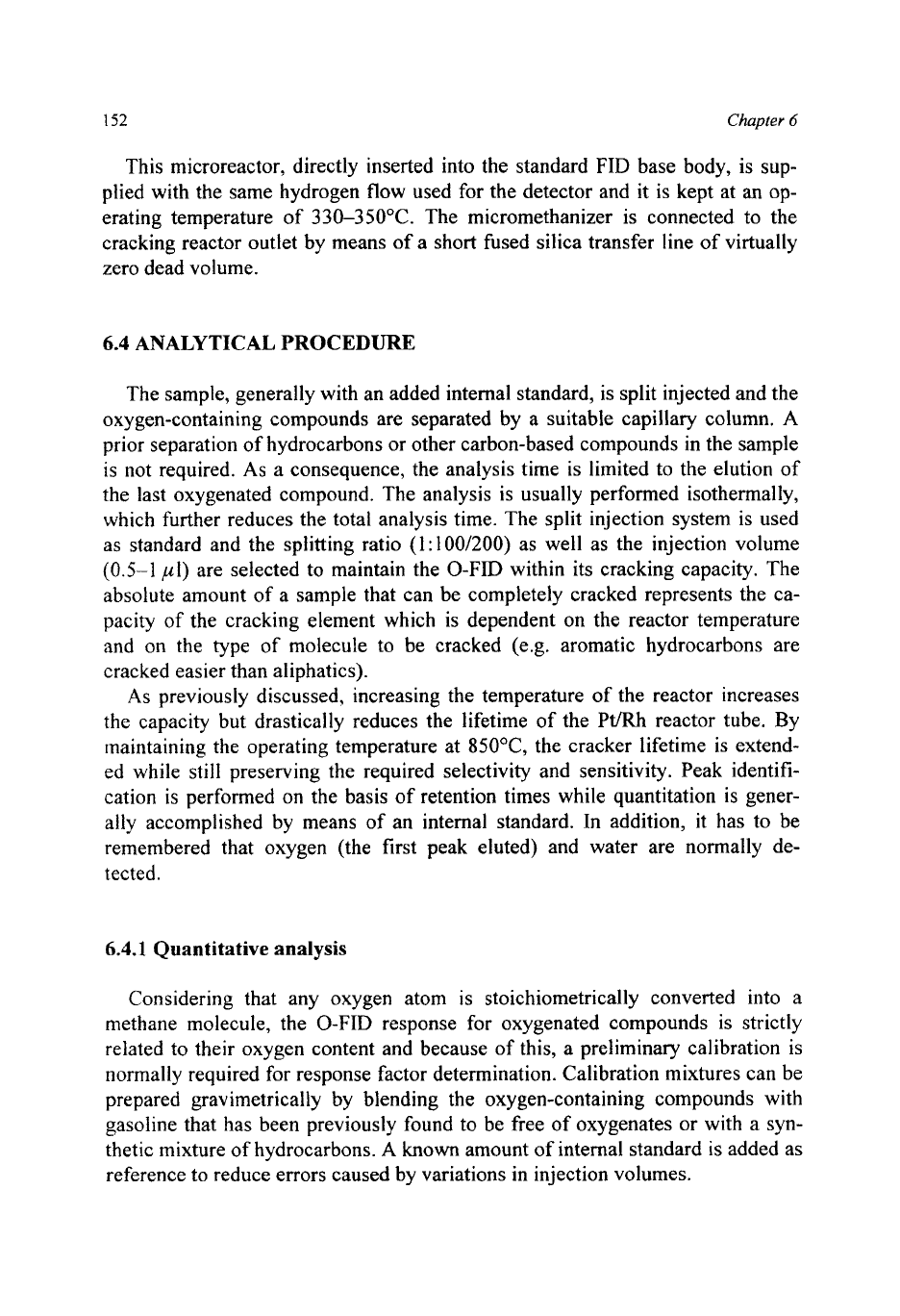
152
Chapter
6
This microreactor, directly inserted into the standard
FID
base body, is sup-
plied with the same hydrogen
flow
used for the detector and it
is
kept at
an
op-
erating temperature of
330-350°C.
The micromethanizer is connected to the
cracking reactor outlet by means of
a
short fused silica transfer line of virtually
zero dead volume.
6.4
ANALYTICAL PROCEDURE
The sample, generally with an added internal standard, is split injected and the
oxygen-containing compounds are separated by a suitable capillary column.
A
prior separation
of
hydrocarbons
or
other carbon-based compounds in the sample
is not required.
As
a consequence, the analysis time
is
limited to the elution of
the last oxygenated compound. The analysis
is
usually performed isothermally,
which further reduces the total analysis time. The split injection system
is
used
as standard and the splitting ratio
(1:100/200)
as well
as
the injection volume
(0.5-1
pl) are selected to maintain the
0-FID
within its cracking capacity. The
absolute amount of a sample that can be completely cracked represents the ca-
pacity of the cracking element which is dependent on the reactor temperature
and on the type of molecule to be cracked (e.g. aromatic hydrocarbons
are
cracked easier than aliphatics).
As
previously discussed, increasing the temperature of the reactor increases
the capacity but drastically reduces the lifetime of the
PtRh
reactor tube. By
maintaining the operating temperature at 85OoC, the cracker lifetime
is
extend-
ed while
still
preserving the required selectivity and sensitivity. Peak identifi-
cation
is
performed on the basis of retention times while quantitation is gener-
ally accomplished by means of an internal standard. In addition, it has to be
remembered that oxygen (the first peak eluted) and water are normally de-
tected.
6.4.1
Quantitative analysis
Considering that any oxygen atom
is
stoichiometrically converted into a
methane molecule, the
0-FID
response for oxygenated compounds
is
strictly
related to their oxygen content and because of this,
a
preliminary calibration is
normally required for response factor determination. Calibration mixtures can be
prepared gravimetrically by blending the oxygen-containing compounds with
gasoline that has been previously found to be free of oxygenates or with
a
syn-
thetic mixture of hydrocarbons.
A
known
amount
of
internal standard
is
added as
reference to reduce errors caused by variations in injection volumes.
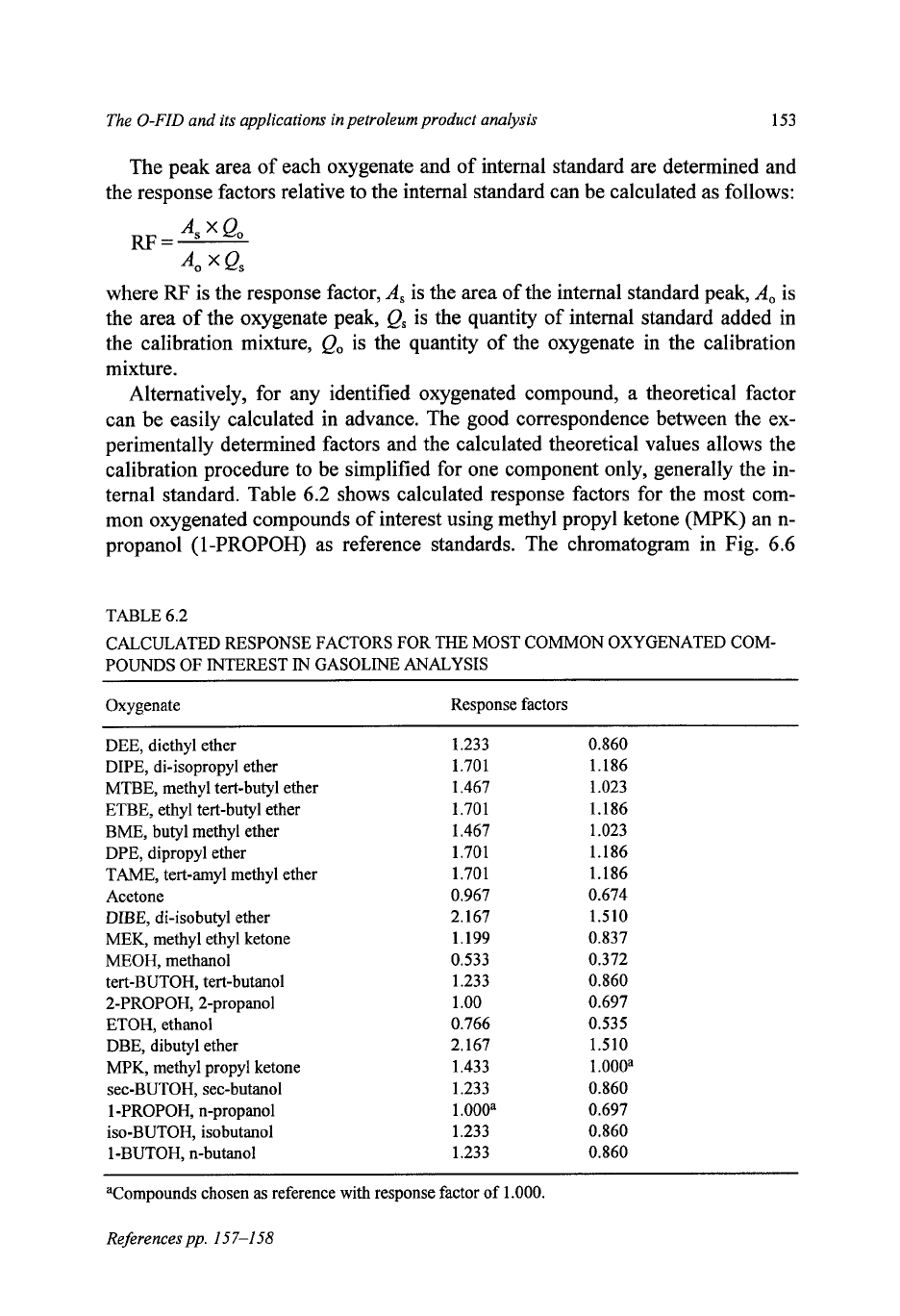
The
0-FID
and its applications in petroleum product analysis
153
The peak area of each oxygenate and of internal standard are determined and
the response factors relative to the internal standard can be calculated as follows:
where
RF
is the response factor,
A,
is the area of the internal standard peak,
A,
is
the area
of
the oxygenate peak,
Qs
is the quantity of internal standard added in
the calibration mixture,
Qo
is the quantity of the oxygenate in the calibration
mixture.
Alternatively, for any identified oxygenated compound, a theoretical factor
can be easily calculated in advance. The good correspondence between the ex-
perimentally determined factors and the calculated theoretical values allows the
calibration procedure to be simplified for one component only, generally the in-
ternal standard. Table
6.2
shows calculated response factors for the most com-
mon oxygenated compounds of interest using methyl propyl ketone
(MPK)
an n-
propanol
(1-PROPOH)
as reference standards. The chromatogram in Fig.
6.6
TABLE
6.2
CALCULATED RESPONSE FACTORS FOR THE MOST COMMON OXYGENATED COM-
POUNDS OF INTEREST
IN
GASOLINE
ANALYSIS
Oxygenate Response factors
DEE, diethyl ether
DIPE, di-isopropyl ether
MTBE, methyl tert-butyl ether
ETBE, ethyl tert-butyl ether
BME, butyl methyl ether
DPE, dipropyl ether
TAME, tert-amyl methyl ether
Acetone
DIBE, di-isobutyl ether
MEK, methyl ethyl ketone
MEOH, methanol
tert-BUTOH, tert-butanol
2-PROPOH, 2-propanol
ETOH, ethanol
DBE, dibutyl ether
MPK, methyl propyl ketone
sec-BUTOH, sec-butanol
1
-PROPOH, n-propanol
iso-BUTOH, isobutanol
1-BUTOH, n-butanol
1.233
1.701
1.467
1.701
1.467
1.701
1.701
0.967
2.167
1.199
0.533
1.233
1
.oo
0.766
2.167
1.433
1.233
1.000a
1.233
1.233
0.860
1.186
1.023
1.186
1.023
1.186
1.186
0.674
1.510
0.837
0.372
0.860
0.697
0.535
1.510
1
.OOoa
0.860
0.697
0.860
0.860
acornpounds chosen as reference with response factor
of
1
.OOO.
References pp.
157-1
58
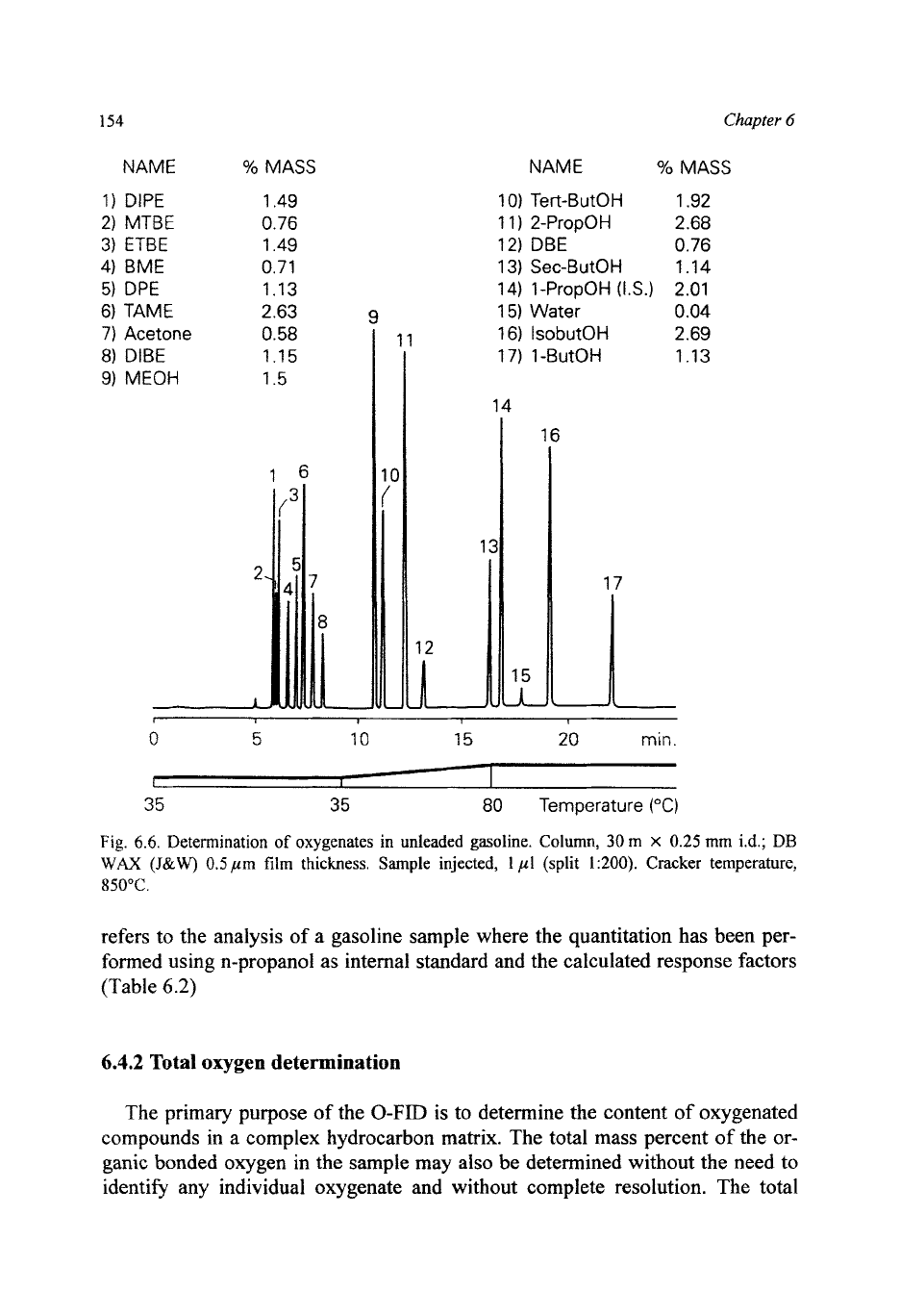
154
NAME
1)
DlPE
2) MTBE
3)
ETBE
4) BME
5) DPE
6)
TAME
7)
Acetone
8)
DlBE
9) MEOH
%
MASS
1.49
0.76
I
.49
0.71
1.13
2.63
0.58
1.15
1.5
2.
9
11
r
i
1
12
Chapter
6
NAME
Yo
MASS
10) Ten-ButOH 1.92
11) 2-PropOH 2.68
12) DBE 0.76
13) See-ButOH 1.14
14) 1-PropOH
(IS.)
2.01
15)
Water
0.04
16)
IsobutOH
2.69
17) I-ButOH 1.13
5
L
i
0 5
10 15 20
min.
I
I
35
35
80
Temperature
("C)
Fig.
6.6.
Determination
of
oxygenates in unleaded gasoline.
Column,
30
m
X
0.25
mm
id.;
DB
WAX
(J&W)
0.5
pm
film
thickness. Sample injected,
1
pI
(split
1:200).
Cracker temperature,
850°C.
refers to the analysis
of
a
gasoline sample where the quantitation
has
been per-
formed using n-propanol as internal standard and the calculated response factors
(Table
6.2)
6.4.2
Total oxygen determination
The primary purpose of the
0-FID
is
to determine the content
of
oxygenated
compounds in a complex hydrocarbon matrix. The total mass percent
of the
or-
ganic bonded oxygen in the sample may
also
be determined without the need
to
identify any individual oxygenate and without complete resolution. The total
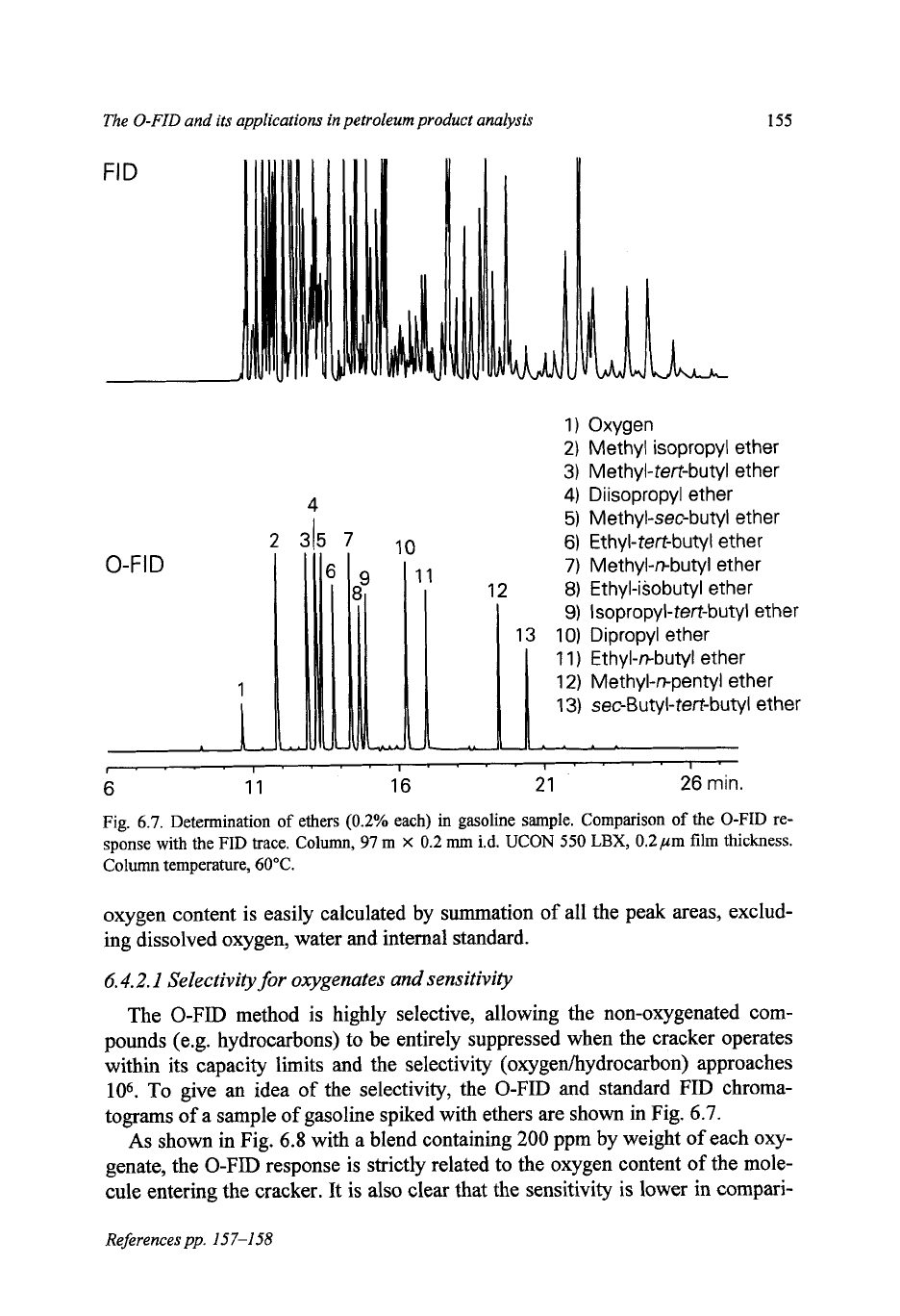
The
0-FID
and its applications
in
petroleum
product analysis
155
0-FI
D
1)
Oxygen
2)
Methyl isopropyl ether
3)
Methyl-tert-butyl ether
4)
Diisopropyl ether
5)
Methyl-sec-butyl ether
6) Ethyl-tert-butyl ether
7)
Methyl-nbutyl ether
8)
Ethyl-isobutyl ether
9)
Isopropyl-tert-butyl ether
4
10) Dipropyl ether
11)
Ethyl-nbutyl ether
12) Methyl-npentyl ether
13)
sec-Butyl-tert-butyl ether
f'"'1
.'..I..'.I."'I.
6
11
16
21
26
min.
Fig.
6.7.
Determination
of
ethers
(0.2%
each) in gasoline sample. Comparison
of
the 0-FID re-
sponse with the FID trace.
Column,
97
m
X
0.2
mm
i.d.
UCON
550
LBX,
0.2pm
film
thickness.
Column temperature,
60°C.
oxygen content is easily calculated by summation
of
all the peak areas, exclud-
ing dissolved oxygen, water and internal standard.
6.4.2.
I
Selectivity
for
oxygenates
and
sensitivity
The
0-FID
method is highly selective, allowing the non-oxygenated com-
pounds (e.g. hydrocarbons) to be entirely suppressed when the cracker operates
within its capacity limits and the selectivity (oxygenhydrocarbon) approaches
lo6.
To give an idea
of
the selectivity, the
0-FID
and standard
FID
chroma-
tograms
of
a sample
of
gasoline spiked with ethers are shown in Fig.
6.7.
As shown in Fig.
6.8
with a blend containing
200
ppm by weight
of
each oxy-
genate, the
0-FID
response
is
strictly related to the oxygen content
of
the mole-
cule entering the cracker. It is also clear that the sensitivity is lower in compari-
References pp.
15
7-1
58
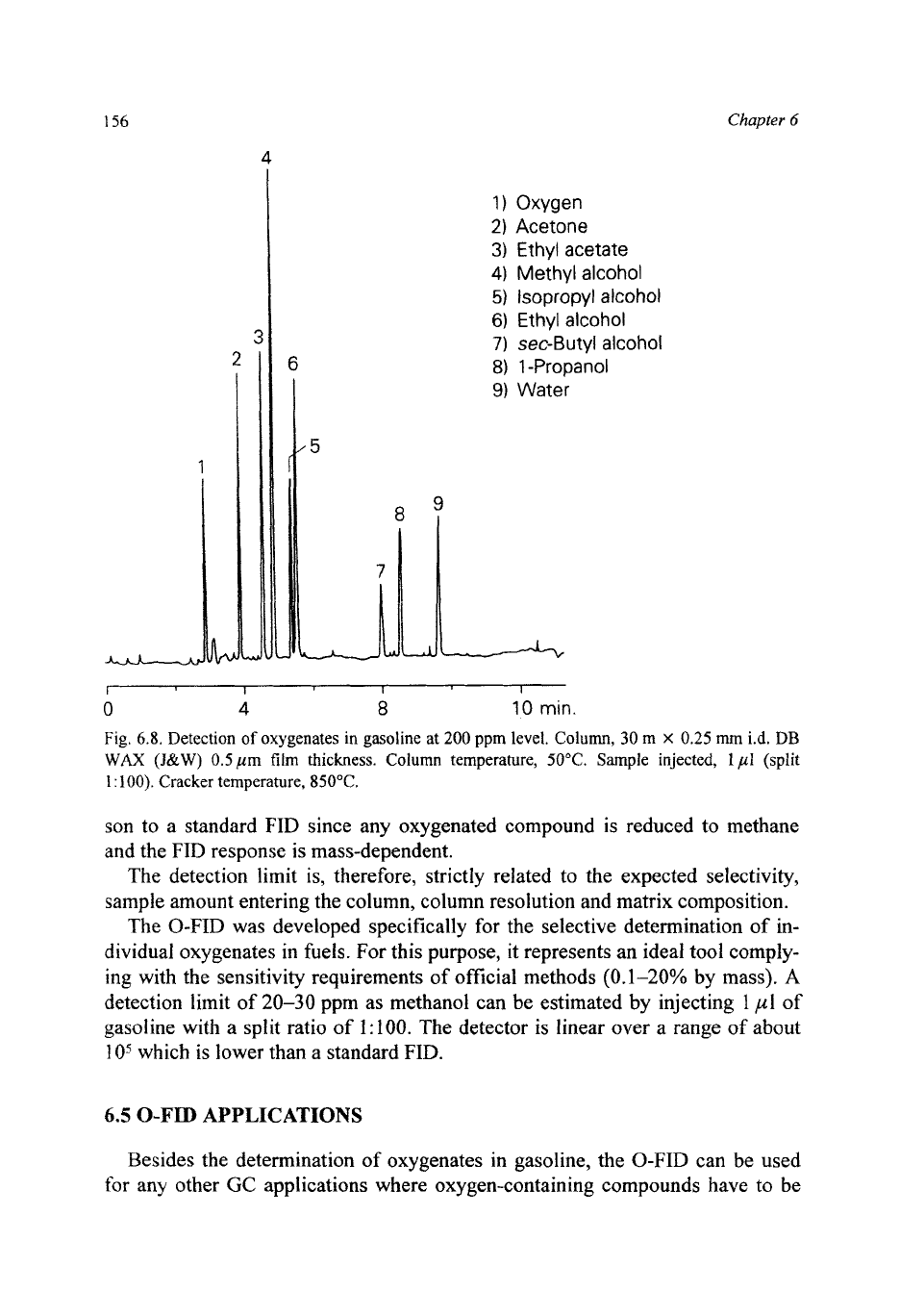
156
Chapter
6
2
1
6
1)
Oxygen
2)
Acetone
3)
Ethyl acetate
4)
Methyl alcohol
5)
lsopropyl
alcohol
6)
Ethyl alcohol
7)
sec-Butyl alcohol
8)
1
-Propano1
9)
Water
I
I
I I
0
4
8 10
min.
Fig.
6.8.
Detection
of
oxygenates in gasoline at
200
ppm level. Column,
30
m
X
0.25
mm
i.d.
DB
WAX
(J&W)
0.5pm
film
thickness. Column temperature,
50°C.
Sample injected,
lyl
(split
1
:
100).
Cracker temperature,
850°C.
son to a standard
FID
since any oxygenated compound is reduced to methane
and the
FID
response
is
mass-dependent.
The detection limit is, therefore, strictly related to the expected selectivity,
sample amount entering the column, column resolution and matrix composition.
The
O-FID
was developed specifically
for
the selective determination of in-
dividual oxygenates in fuels.
For
this purpose, it represents an ideal tool comply-
ing with the sensitivity requirements of official methods
(0.1-20%
by mass).
A
detection limit of
20-30
ppm as methanol can be estimated by injecting
1
pl
of
gasoline with a split ratio
of
1:lOO.
The detector is linear over a range of about
1
O5
which
is
lower than a standard
FID.
6.5
O-FID
APPLICATIONS
Besides the determination
of
oxygenates in gasoline, the
O-FID
can be used
for
any other
GC
applications where oxygen-containing compounds have to be
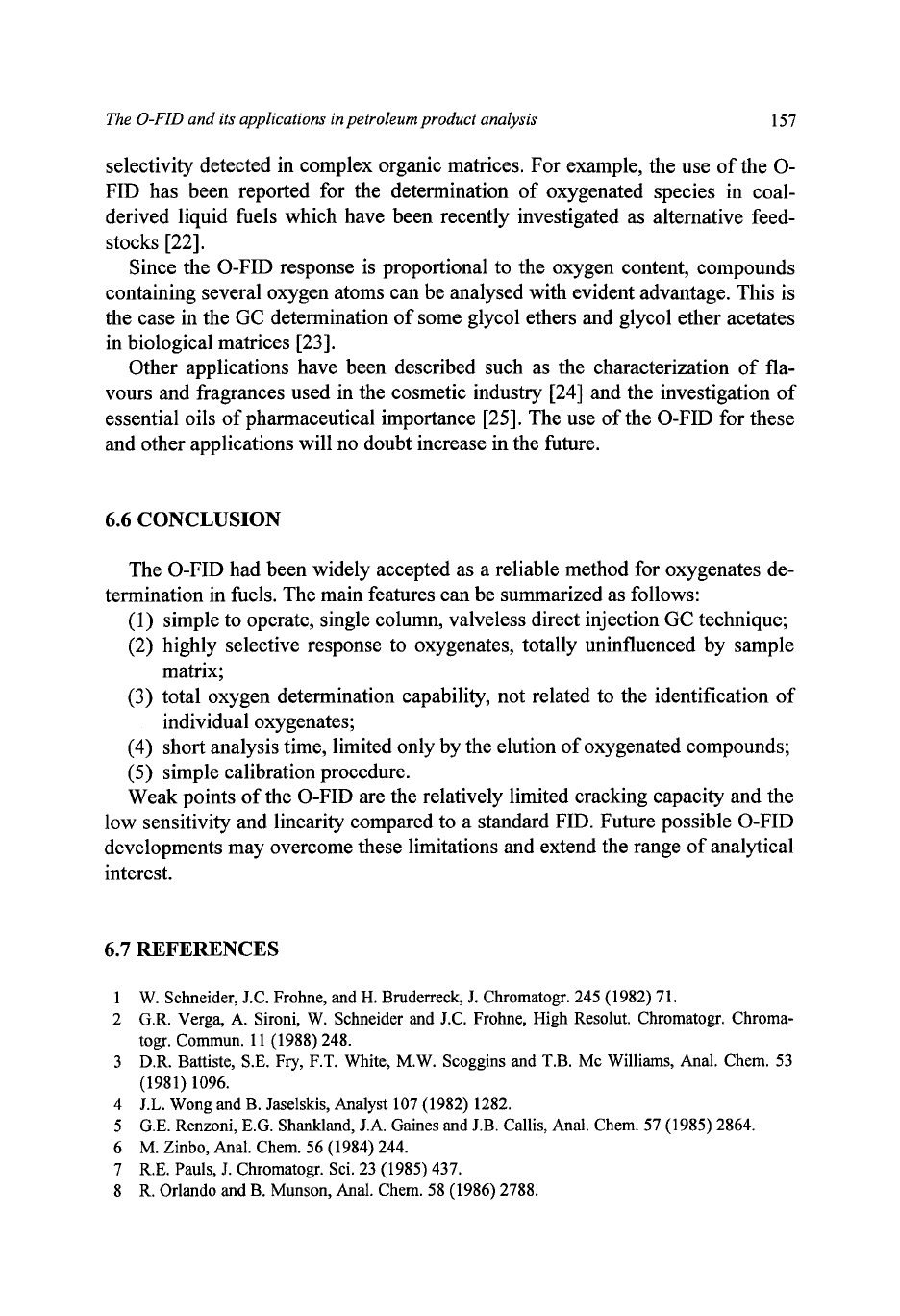
The
0-FID
and its applications
in
petroleum product analysis
157
selectivity detected in complex organic matrices. For example, the use of the
0-
FID has been reported for the determination of oxygenated species in coal-
derived liquid fuels which have been recently investigated as alternative feed-
stocks
[22].
Since the 0-FID response is proportional to the oxygen content, compounds
containing several oxygen atoms can be analysed with evident advantage. This is
the case in the GC determination of some glycol ethers and glycol ether acetates
in biological matrices
[23].
Other applications have been described such as the characterization of
fla-
vours and fragrances used in the cosmetic industry
[24]
and the investigation of
essential oils of pharmaceutical importance
[25].
The use of the 0-FID for these
and other applications will no doubt increase in the future.
6.6 CONCLUSION
The 0-FID had been widely accepted as a reliable method for oxygenates de-
(1)
simple to operate, single column, valveless direct injection GC technique;
(2)
highly selective response to oxygenates, totally uninfluenced by sample
(3)
total oxygen determination capability, not related to the identification of
(4)
short analysis time, limited only by the elution of oxygenated compounds;
(5)
simple calibration procedure.
Weak points of the 0-FID are the relatively limited cracking capacity and the
low sensitivity and linearity compared to a standard FID. Future possible 0-FID
developments may overcome these limitations and extend the range of analytical
interest.
termination in fuels. The main features can be summarized as follows:
matrix;
individual oxygenates;
6.7
REFERENCES
1
W. Schneider, J.C. Frohne, and
H.
Bruderreck,
J.
Chromatogr. 245 (1982) 71.
2 G.R. Verga, A. Sironi, W. Schneider and J.C. Frohne, High Resolut. Chromatogr. Chroma-
togr. Commun.
11
(1988) 248.
3
D.R. Battiste, S.E.
Fry,
F.T. White, M.W. Scoggins and T.B. Mc Williams, Anal. Chem. 53
(1981) 1096.
4 J.L. Wong and B. Jaselskis, Analyst 107 (1982) 1282.
5
G.E.
Renzoni,
E.G.
Shankland, J.A. Gaines and J.B. Callis, Anal. Chem. 57 (1985) 2864.
6
M.
Zinbo, Anal. Chem.
56
(1984) 244.
7 R.E. Pauls, J. Chromatogr. Sci. 23 (1985) 437.
8
R.
Orlando and B. Munson, Anal. Chem. 58 (1986) 2788.
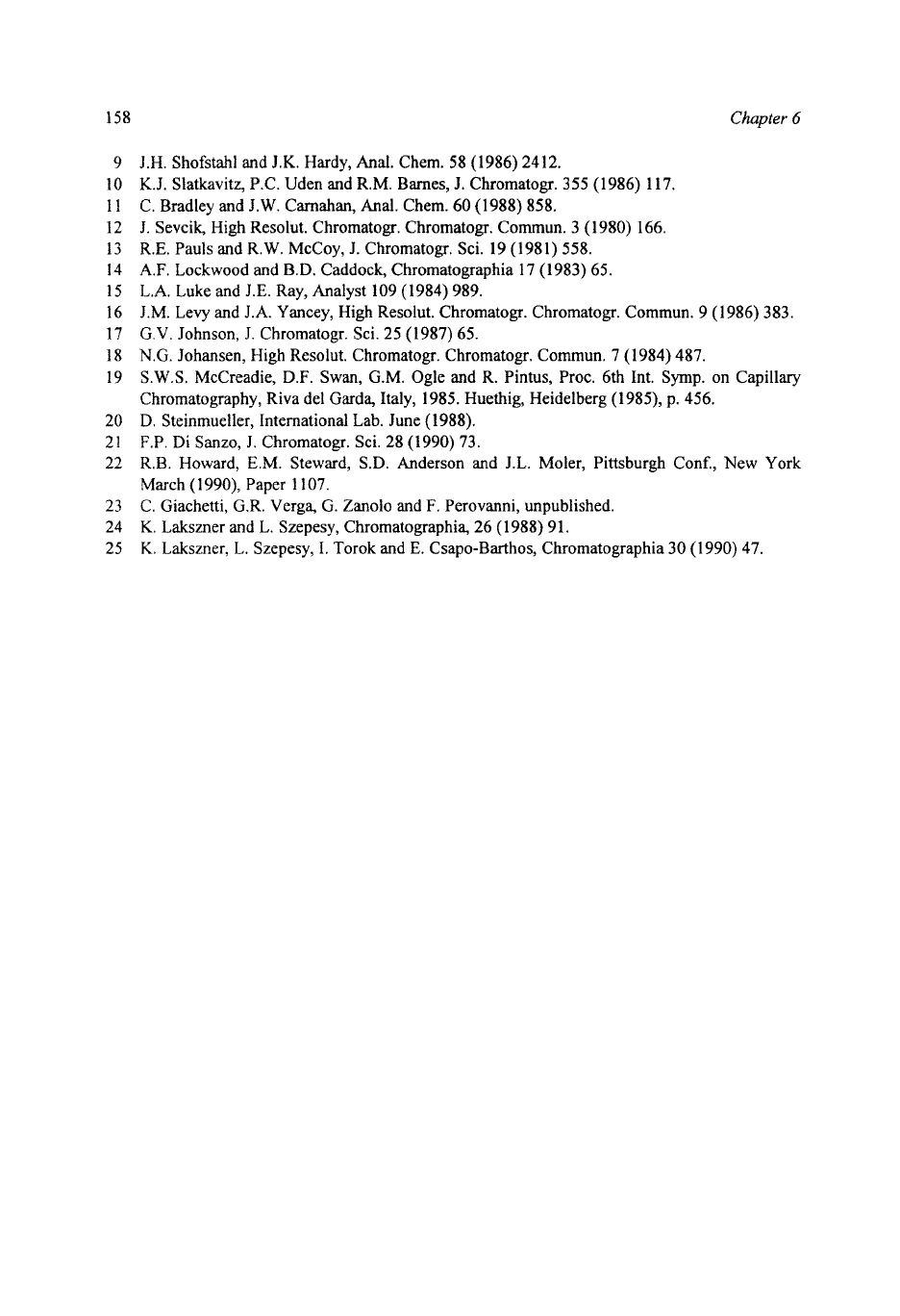
158
Chapter
6
9
10
11
12
13
14
15
16
17
18
19
20
21
22
23
24
25
J.H. Shofstahl and J.K. Hardy, Anal. Chem.
58 (1986) 2412.
K.J. Slatkavitz, P.C. Uden and R.M. Barnes, J. Chromatogr.
355
(1986) 117.
C. Bradley and J.W. Carnahan, Anal. Chem.
60 (1988)
858.
J. Sevcik, High Resolut. Chromatogr. Chromatogr. Commun.
3
(1980)
166.
R.E. Pads and
R.W.
McCoy, J. Chromatogr. Sci.
19 (1981)
558.
A.F. Lockwood and
B.D.
Caddock, Chromatographia
17 (1983) 65.
L.A. Luke and J.E. Ray, Analyst
109 (1984) 989.
J.M.
Levy and J.A. Yancey, High Resolut. Chromatogr. Chromatogr. Commun.
9 (1986)
383.
G.V. Johnson, J. Chromatogr. Sci.
25 (1987) 65.
N.G.
Johansen, High Resolut. Chromatogr. Chromatogr. Commun.
7
(1984) 487.
S.W.S. McCreadie,
D.F.
Swan, G.M. Ogle and R. Pintus, Proc. 6th Int. Symp. on Capillary
Chromatography, Riva del Garda, Italy,
1985.
Huethig, Heidelberg
(1985),
p.
456.
D.
Steinmueller, International Lab. June
(1988).
F.P.
Di Sanzo,
J.
Chromatogr. Sci.
28 (1990)
73.
R.B.
Howard, E.M. Steward,
S.D.
Anderson and J.L. Moler, Pittsburgh Conf., New York
March
(1
990),
Paper
1
107.
C.
Giachetti, G.R. Verga, G.
Zanolo
and
F.
Perovanni, unpublished.
K.
Lakszner and L. Szepesy, Chromatographia,
26 (1988) 91.
K. Lakszner, L. Szepesy,
I.
Torok and
E.
Csapo-Barthos, Chromatographia
30
(1990) 47.
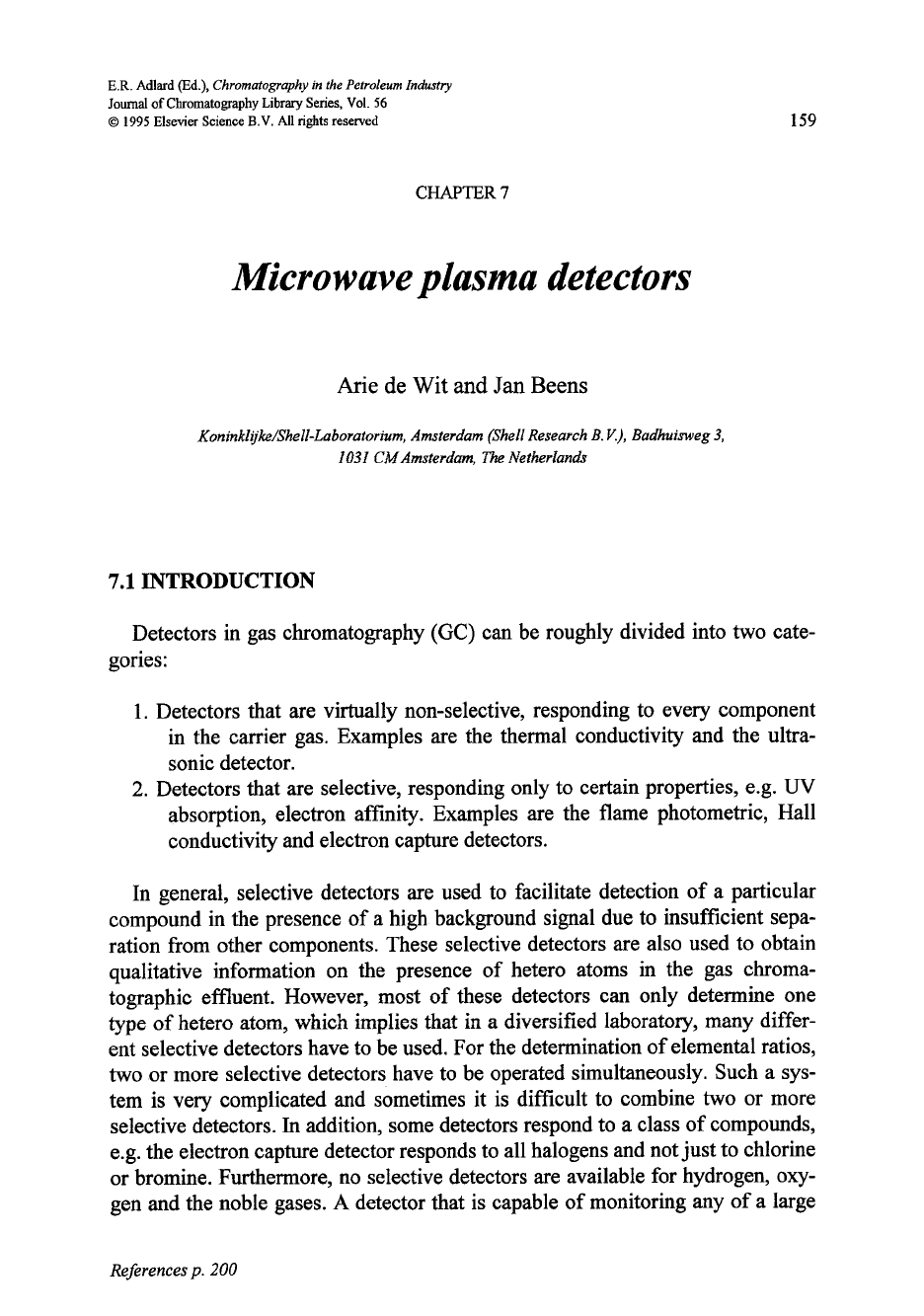
E.R.
Adlard
(Ed.),
Chromatography
in
the Petroleum
Industry
Journal
of
Chromatography
Library
Series,
Val. 56
0
1995
Elsevier Science
B.V.
All
rights
reserved
159
CHAPTER
7
Microwave
plasma
detectors
Arie
de Wit
and
Jan
Beens
KoninklijkeShell-Laboratorium,
Amsterdam (Shell Research
B.
V.),
Badhuisweg
3,
1031
CMAmsterdam,
The
Nethedands
7.1
INTRODUCTION
Detectors in gas chromatography
(GC)
can be roughly divided into
two
cate-
gories:
1.
Detectors that are virtually non-selective, responding to every component
in the carrier gas. Examples are the thermal conductivity and the ultra-
sonic detector.
2.
Detectors that are selective, responding only to certain properties, e.g.
UV
absorption, electron affinity. Examples are the flame photometric, Hall
conductivity and electron capture detectors.
In general, selective detectors are used to facilitate detection of a particular
compound in the presence of a high background signal due to insufficient sepa-
ration from other components. These selective detectors are also used to obtain
qualitative information on the presence of hetero atoms in the gas chroma-
tographic effluent. However, most of these detectors can only determine one
type of hetero atom, which implies that in a diversified laboratory, many differ-
ent selective detectors have to be used. For the determination of elemental ratios,
two
or more selective detectors have to be operated simultaneously. Such a sys-
tem is very complicated and sometimes it is difficult to combine
two
or more
selective detectors.
In
addition, some detectors respond to a class of compounds,
e.g. the electron capture detector responds to all halogens and not just to chlorine
or bromine. Furthermore, no selective detectors are available for hydrogen, oxy-
gen and the noble gases.
A
detector that is capable of monitoring any of a large
Referencesp.
200
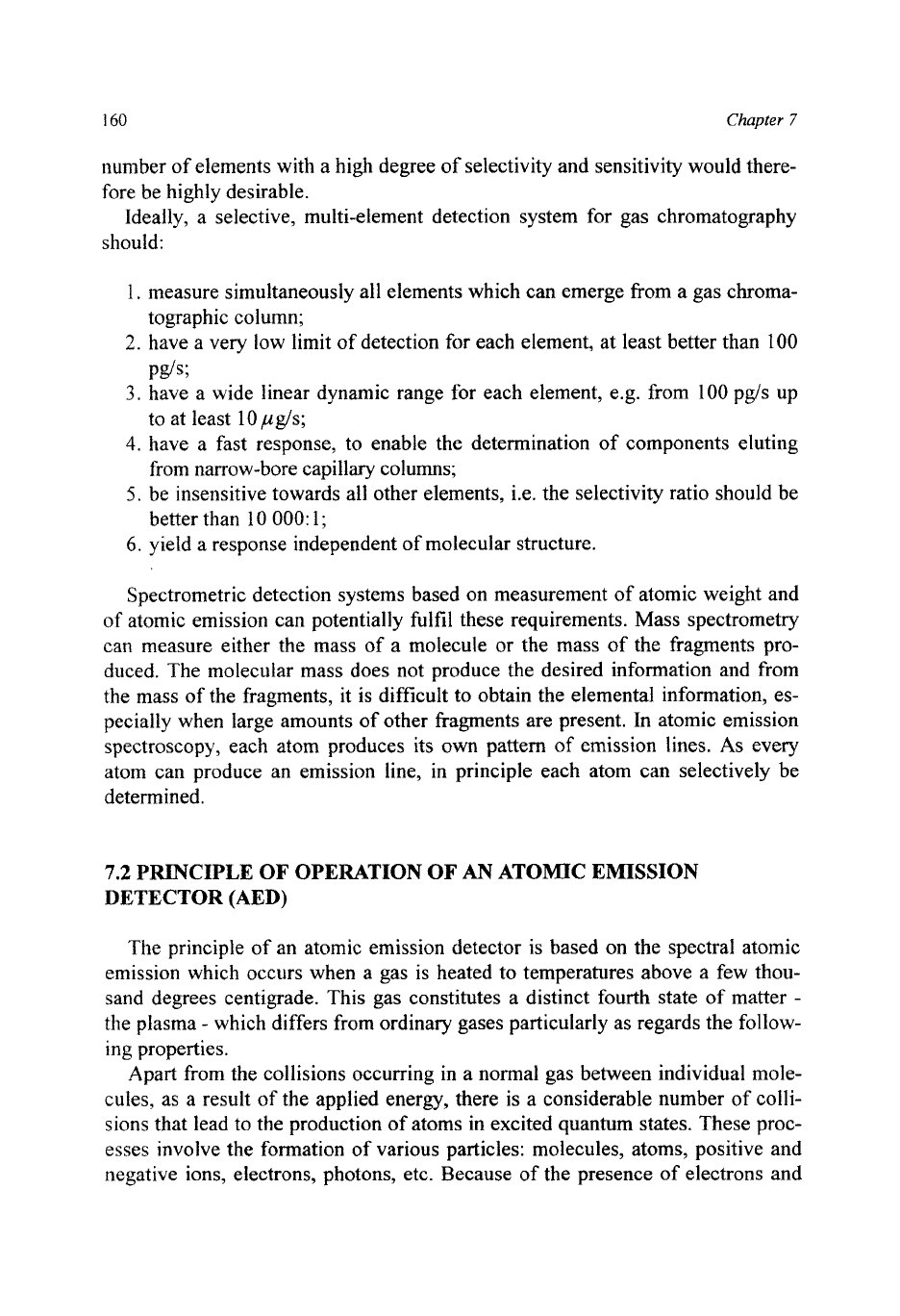
160
Chapter
7
number of elements with a high degree of selectivity and sensitivity would there-
fore be highly desirable.
Ideally, a selective, multi-element detection system for gas chromatography
should:
1.
2.
3.
4.
5.
6.
measure simultaneously
all
elements which can emerge from a gas chroma-
tographic column;
have a very low limit of detection for each element, at least better than
100
have a wide linear dynamic range
for
each element, e.g. from
100
pg/s up
to at least
10
pg/s;
have a fast response, to enable the determination of components eluting
from narrow-bore capillary columns;
be
insensitive towards all other elements, i.e. the selectivity ratio should be
better than
10
000:
1
;
yield
a
response independent of molecular structure.
Pg/%
Spectrometric detection systems based on measurement of atomic weight and
of
atomic emission can potentially fulfil these requirements. Mass spectrometry
can measure either the mass of
a
molecule
or
the mass of the fragments pro-
duced. The molecular mass does not produce the desired information and from
the mass of the fragments, it
is
difficult to obtain the elemental information, es-
pecially when large amounts
of
other fragments are present.
In
atomic emission
spectroscopy, each atom produces its own pattern of emission lines.
As
every
atom can produce an emission line, in principle each atom can selectively be
determined.
7.2
PRINCIPLE
OF
OPERATION
OF AN
ATOMIC
EMISSION
DETECTOR
(AED)
The principle of an atomic emission detector
is
based on the spectral atomic
emission which occurs when a gas is heated to temperatures above
a
few thou-
sand degrees centigrade. This gas constitutes a distinct fourth state of matter
-
the plasma
-
which differs from ordinary gases particularly as regards the follow-
ing properties.
Apart from the collisions occurring in a normal gas between individual mole-
cules, as a result of the applied energy, there
is
a considerable number of colli-
sions that lead to the production of atoms in excited quantum states. These proc-
esses involve the formation of various particles: molecules, atoms, positive and
negative ions, electrons, photons, etc. Because of the presence
of
electrons and
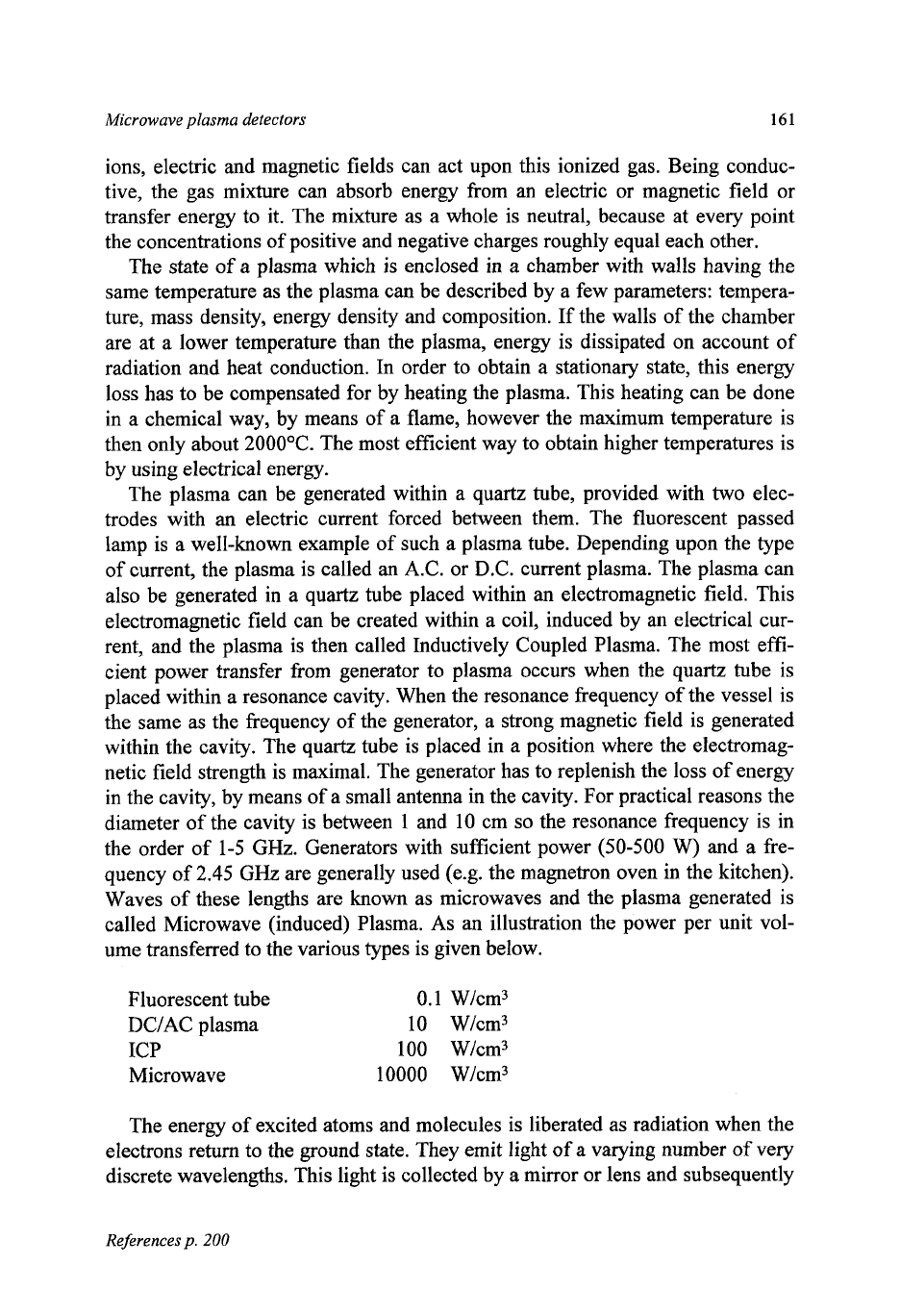
Microwave plasma detectors 161
ions, electric and magnetic fields can act upon this ionized gas. Being conduc-
tive, the gas mixture can absorb energy from an electric or magnetic field or
transfer energy to it. The mixture as a whole is neutral, because at every point
the concentrations of positive and negative charges roughly equal each other.
The state of a plasma which is enclosed in a chamber with walls having the
same temperature as the plasma can be described by a few parameters: tempera-
ture, mass density, energy density and composition. If the walls of the chamber
are at a lower temperature than the plasma, energy is dissipated on account
of
radiation and heat conduction. In order to obtain a stationary state, this energy
loss has to be compensated for by heating the plasma. This heating can be done
in a chemical way, by means of a flame, however the maximum temperature is
then only about 2000°C. The most efficient way to obtain higher temperatures is
by using electrical energy.
The plasma can be generated within a quartz tube, provided with two elec-
trodes with an electric current forced between them. The fluorescent passed
lamp is a well-known example of such a plasma tube. Depending upon the type
of current, the plasma is called an A.C. or
D.C.
current plasma. The plasma can
also be generated in a quartz tube placed within an electromagnetic field. This
electromagnetic field can be created within a coil, induced by an electrical cur-
rent, and the plasma is then called Inductively Coupled Plasma. The most effi-
cient power transfer from generator to plasma occurs when the quartz tube is
placed within a resonance cavity. When the resonance frequency of the vessel is
the same as the frequency of the generator, a strong magnetic field is generated
within the cavity. The quartz tube is placed in a position where the electromag-
netic field strength is maximal. The generator has to replenish the loss of energy
in the cavity, by means of a small antenna in the cavity. For practical reasons the
diameter of the cavity is between
1
and
10
cm
so
the resonance frequency is in
the order of
1-5
GHz. Generators with sufficient power
(50-500
W)
and a fre-
quency of
2.45
GHz
are generally used (eg the magnetron oven in the kitchen).
Waves
of these lengths are known as microwaves and the plasma generated is
called Microwave (induced) Plasma. As an illustration the power per unit vol-
ume transferred to the various types is given below.
Fluorescent tube
0.1
Wlcm3
DCIAC
plasma
10
WIcm3
ICP
100
Wlcm3
Microwave
10000
WIcm3
The energy of excited atoms and molecules is liberated as radiation when the
electrons return to the ground state. They emit light of a varying number of very
discrete wavelengths. This light is collected by a mirror or lens and subsequently
References p.
200
